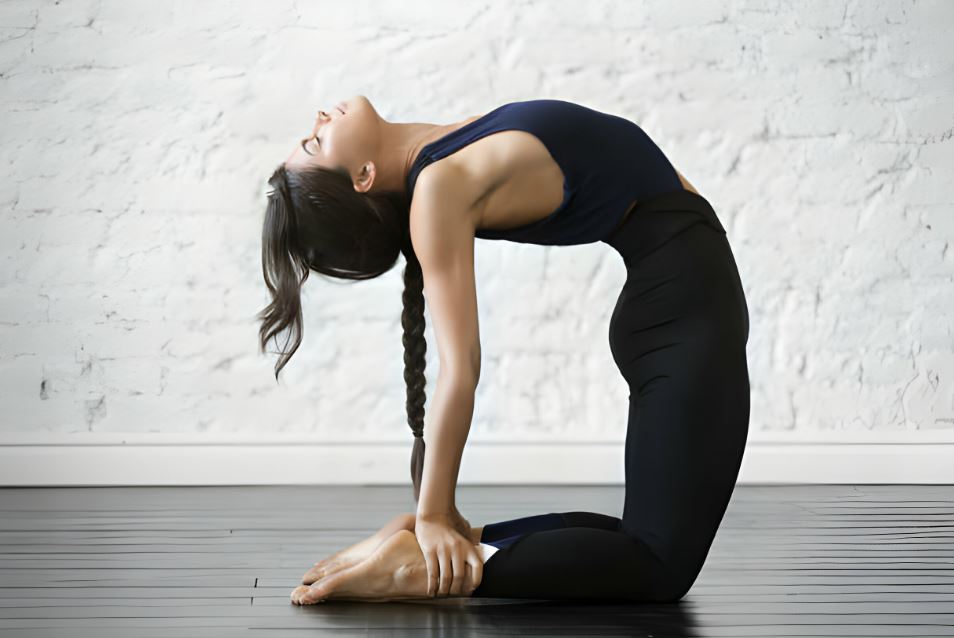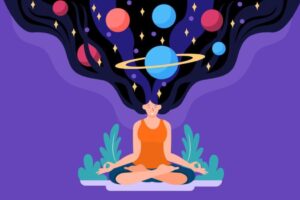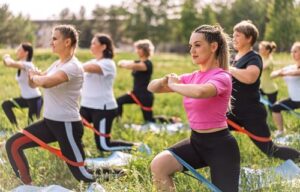Ustrasana, or Camel Pose, is a quintessential yoga asana known for its profound effects on both the body and mind. This backbend posture, when practiced correctly, offers a myriad of benefits. In this article, we will explore the step-by-step procedure for Ustrasana, its extensive list of benefits, and crucial contraindications to ensure a safe and effective practice.
Procedure:
Executing Ustrasana demands mindful attention to detail to prevent strain and injury. Follow these guidelines to master the art of Camel Pose:
1. Start in a Kneeling Position:
- Begin in a kneeling position on your mat with your knees hip-width apart.
- Place your hands on your hips, fingers pointing downward.
2. Engage Core Muscles:
- Inhale deeply and engage your core muscles to support the lower back.
- Tilt your pelvis forward, elongating your tailbone toward the floor.
3. Reach Backwards:
- Exhale and slowly reach backward, one hand at a time, toward your heels.
- Ensure your thighs remain perpendicular to the floor.
4. Arch Your Back:
- Gently arch your back, allowing your head to fall back.
- Keep your neck in a neutral position, avoiding excessive strain.
5. Hold the Pose:
- Maintain the posture for 20-30 seconds initially, gradually extending the duration as your practice progresses.
- Breathe deeply and evenly, focusing on opening the chest and stretching the front of your body.
6. Return to the Starting Position:
- To release the pose, bring your hands back to your hips and slowly return to the kneeling position.
Benefits:
1. Improved Posture:
- Ustrasana plays a pivotal role in correcting rounded shoulders and promoting an upright, healthy posture.
- Regular practice strengthens the back muscles, reducing the risk of slouching.
2. Enhanced Flexibility:
- This pose stretches the entire front body, including the chest, abdomen, and quadriceps.
- Regular practice increases overall flexibility, particularly in the spine and hip flexors.
3. Stimulated Digestive System:
- Ustrasana aids digestion by compressing and massaging abdominal organs.
- This can help alleviate digestive issues and promote a healthy gut.
4. Increased Lung Capacity:
- The expansive chest opening allows for deeper breaths, enhancing lung capacity.
- Improved respiratory function supports overall well-being and vitality.
5. Emotional Release:
- Ustrasana is renowned for its heart-opening qualities, promoting emotional release and a sense of vulnerability.
- Practitioners often experience a cathartic release of stored emotions.
6. Endocrine System Stimulation:
- The backward bend stimulates the thyroid and parathyroid glands, potentially aiding in hormonal regulation.
- This can be particularly beneficial for those dealing with metabolic and calcium level imbalances.
7. Improved Posture Awareness:
- Beyond correcting poor posture, Ustrasana enhances overall awareness of body alignment.
- Practitioners develop a heightened sense of how the spine, shoulders, and pelvis are interconnected.
Contraindications:
While Ustrasana offers a plethora of benefits, it may not be suitable for everyone. Certain contraindications need to be considered to ensure a safe practice:
1. Back or Neck Injuries:
- Individuals with recent or chronic back or neck injuries should consult a healthcare professional before attempting Ustrasana.
- Modifications or alternative poses may be recommended.
2. High or Low Blood Pressure:
- Ustrasana can temporarily increase blood pressure. Individuals with hypertension or hypotension should practice with caution.
- Modify the pose by using props or choose gentler alternatives.
3. Migraines or Headaches:
- The intense backward bend may trigger migraines or headaches in susceptible individuals.
- Practice mindfully and discontinue if any discomfort arises.
4. Knee Issues:
- Those with knee problems should pad their knees or avoid Ustrasana to prevent exacerbating existing issues.
- Consult with a healthcare provider for personalized advice.
5. Pregnancy:
- Pregnant women should avoid deep backbends, including Ustrasana, especially in the later stages of pregnancy.
- Prenatal yoga or poses specifically designed for pregnancy are safer alternatives.
Ustrasana, when practiced with the right technique and awareness, can be a transformative yoga pose. Its benefits extend beyond the physical, positively impacting mental and emotional well-being. However, it’s crucial to approach this asana with mindfulness, understanding individual limitations, and seeking guidance from qualified instructors or healthcare professionals if necessary. Incorporating Ustrasana into your routine, along with a balanced yoga practice, can contribute to a healthier and more vibrant lifestyle. Remember, the journey of yoga is personal, and each practitioner should honor their unique body and needs.
Visit: Yoga Teacher Training in Rishikesh | 200 Hour Yoga Teacher Training in Rishikesh | Yoga Retreat in Rishikesh | 100 Hour Yoga Course in Rishikesh | 500 Hour Yoga Teacher Training in Rishikesh India



